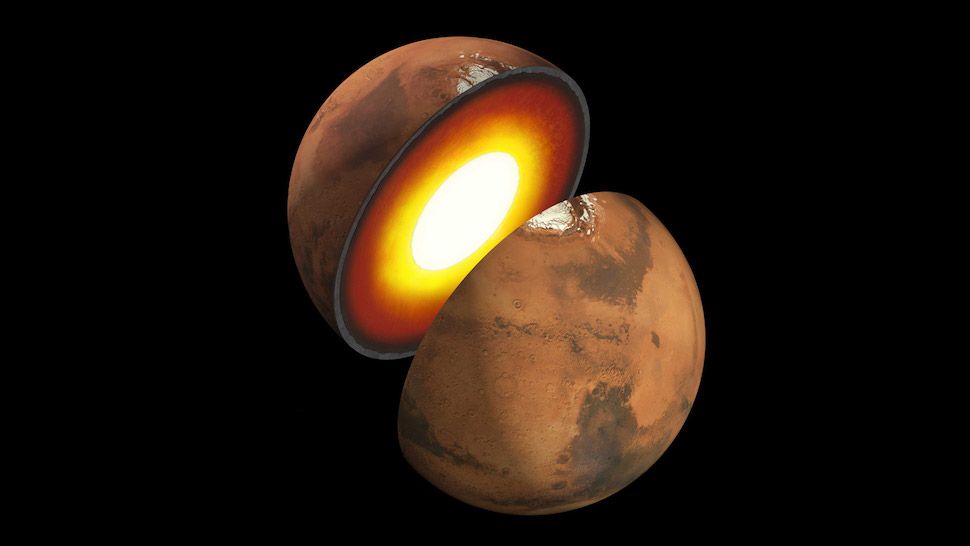The core of Mars can look bigger than it actually is because of a previously unknown layer of molten rock surrounding it, scientists suggest with a pair of new studies.
This may finally solve a mystery from two years ago about how the center of Mars appeared surprisingly large and soft, the researchers said.
The team arrived at this conclusion by taking advantage of the fact Mars is the only planet (other than Earth) to receive a scan of its deep interior. Using sensors on NASA’s InSight lander, which touched down on the Red Planet in 2018, scientists (some of whom are associated with the new studies) analyzed seismic waves that rippled through Martian rock to yield insights on the planet’s inner structure.
A trio of studies in 2021 based on those scans found the Martian core was potentially much larger than expected. The 2021 estimate suggested the center of the Red Planet was about 2,235 miles (3,600 kilometers) in diameter, or “about half the size of the planet,” Amir Khan, a planetary scientist at the Swiss Federal Institute of Technology in Zurich, told Space.com. (In comparison, Earth’s core is about 4,350 miles [7,000 km] wide.)
Related: Seismic waves inside Mars’ core hint at how it became hostile to life
The 2021 findings further suggested the Martian core was unexpectedly low in density compared to Earth’s core, potentially made of liquid iron mixed with lighter elements such as sulfur, carbon, oxygen and hydrogen.
“The discovery took everyone a bit by surprise,” Khan said. Earth’s core is about 90 percent iron and nickel by weight, and about 10 percent lighter elements by weight. In contrast, the 2021 studies found the Martian core was apparently about 20 percent lighter elements by weight. “That was simply too much,” Khan said.
The presence of these lighter elements was difficult to explain using existing models of Martian formation. “To get all these lighter weight elements into the core of Mars while it’s forming is just very, very difficult to do,” Khan said.
Since the 2021 studies appeared, InSight detected more Martian seismic waves, produced by a meteorite impact on Mars far away from the lander. “The impact produced a lot of energy, generating seismic waves that traversed the core of Mars,” Khan said. “Up until then, we didn’t have any of those to examine. They allowed us to gain a completely new picture of the interior of Mars, especially deep structures that we couldn’t illuminate before.”
Two new studies now estimate the center of Mars is about 2,050 to 2,080 miles (3,300 to 3,350 km) in diameter. All in all, the Martian core “is 30 percent smaller in volume than previous estimates,” Henri Samuel, a planetary dynamicist at Paris Cité University in France, told Space.com.
The new studies also suggested the core is much denser than the 2021 studies estimated, “and that fewer light elements are needed in the core,” Khan said. “Our estimates are now that the Martian core is about 9 to 14 percent lighter elements by weight, which makes more sense.”
Both the new studies reveal the liquid iron core of Mars is surrounded by a previously unknown layer of soft molten silicon-rich rock about 93 miles (150 km) thick. The way in which this layer reflected seismic waves helped explain why the 2021 studies were off in their estimates of the size of the Red Planet’s core.
The two studies, however, disagree on the density and composition of this newfound layer. More specifically, Samuel and his colleagues suggested a very dense layer rich in sulfur and oxygen, while Khan and his colleagues suggested a less dense version with a relatively lower quantity of those elements.
A denser layer of silicon-rich molten rock could act like a thermal insulator layer, preventing the core from cooling and solidifying, Samuel explained. This, in turn, would help explain why Mars lacks a planetary magnetic field — Earth’s magnetic field results from the way in which its solidifying inner core stirs up its outer liquid core, creating powerful electric currents that generate a magnetic field.
Still, magnetic activity was seen in the Martian crust during the first 500 million to 800 million years of the Red Planet’s evolution, Samuel noted. Possible explanations for this magnetic activity may include cosmic impacts, he said, or interactions with ancient Martian moons that have since disappeared.
In contrast, a less dense silicon-heavy molten rock layer might help explain other details seen on Mars. For example, such a layer could fuel volcanism, including lava flows that helped form Tharsis, the solar system‘s largest volcanic structure, and the volcanic activity that may still exist at the plains of a Martian region known as Elysium Planitia.
All in all, with the discovery of this new layer, “we need to go back to re-analyze and re-interpret the four year-long seismic record and all other geophysical observables in the light of this new paradigm,” Samuel said. “This could lead to additional discoveries on the deep structure of the Martian mantle and its core.”
The scientists detailed their findings in two separate studies in the journal Nature.

